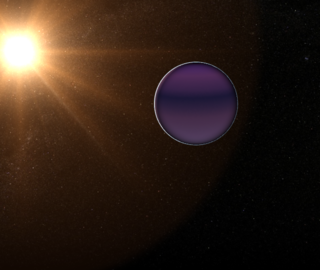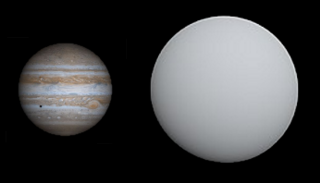The Hungarian Automated Telescope Network (HATNet) project is a network of six small fully automated "HAT" telescopes. The scientific goal of the project is to detect and characterize extrasolar planets using the transit method. This network is used also to find and follow bright variable stars. The network is maintained by the Center for Astrophysics | Harvard & Smithsonian.

HD 76700 b is an exoplanet orbiting the G-type main sequence star HD 76700 approximately 198 light years away in the southern constellation Volans. The planet was discovered in 2002, and was announced in 2003.
The Kilodegree Extremely Little Telescope is an astronomical observation system formed by two robotic telescopes that are conducting a survey for transiting exoplanets around bright stars. The project is jointly administered by members of Ohio State University Department of Astronomy, the Vanderbilt University Department of Physics and Astronomy Astronomy Group, the Lehigh University Department of Physics, and the South African Astronomical Observatory (SAAO).

KELT-9b is an exoplanet—more specifically, an ultra-hot Jupiter—that orbits the late B-type/early A-type star KELT-9, located about 670 light-years from Earth. Detected using the Kilodegree Extremely Little Telescope, the discovery of KELT-9b was announced in 2016.
KELT-18b is a hot Jupiter orbiting the F-type main sequence star KELT-18 approximately 1,058 light years away in the northern circumpolar constellation Ursa Major. The planet was discovered using the transit method, and was announced in June 2017.
KELT-10, also known as CD−47°12635, is a sun-like star in the southern constellation Telescopium. It has an apparent magnitude of 10.62, making it readily visible in telescopes, but not to the naked eye. Parallax measurements from the Gaia spacecraft place the star at a distance of 617 light years; it is currently receding with a radial velocity of 31.6 km/s.
KELT-1 is a F-type main-sequence star. Its surface temperature is 6518±50 K. It is similar to the Sun in its concentration of heavy elements, with a metallicity Fe/H index of 0.008±0.073, but is much younger at an age of 1.75±0.25 billion years. The star is rotating very rapidly.
HD 197037 is a binary star system. Its primary, HD 197037A, is a F-type main-sequence star. Its surface temperature is 6150±34 K. HD 197037A is depleted in heavy elements compared to the Sun, with a metallicity Fe/H index of −0.16±0.03, but is younger at an age of 3.408±0.924 billion years.
HD 77338 is a K-type subgiant star which has recently exhausted its hydrogen fuel and has started to expand. Its surface temperature is 5315 K. HD 77338 is enriched in its concentration of heavy elements compared to the Sun, with a metallicity Fe/H index of 0.16 but is much older at an age of 9.5 billion years.
HATS-3 is a F-type main-sequence star. Its surface temperature is 6351±76 K. HATS-3 is relatively depleted in its concentration of heavy elements, with a metallicity Fe/H index of −0.157±0.07, but is slightly younger than the Sun at an age of 3.2+0.6
−0.4 billion years.

KELT-10b is an exoplanet orbiting the G-type main-sequence star KELT-10 approximately 618 light-years away in the southern constellation Telescopium. It was discovered using the transit method, and was announced in 2016.
Qatar-3 is a faint 12th magnitude star located in the northern constellation Andromeda. It is host to a transiting planet. With a radial velocity of 10.99 km/s, it is currently drifting away from the Solar System, and is currently located 2,400 light years away based on parallax.
KELT-3 is a star in the zodiac constellation Leo. With an apparent magnitude of 9.82, it is too faint to be seen with the naked eye, but can be detected using a telescope. It is currently located around 690 light years away, based on parallax measurements.
KELT-6, also known as BD+31 2447, is a star in the constellation Coma Berenices. With an apparent magnitude of 10.34, it is impossible to see with the unaided eye, but can be seen with a powerful telescope. The star is located 791 light years away from the Solar System based on parallax, but is drifting away with a radial velocity of 1.62 km/s.
HAT-P-65 is a faint star located in the equatorial constellation Equuleus. With an apparent magnitude of 13.16, it requires a telescope to be seen. The star is located 2,460 light-years (750 pc) away from Earth, but is drifting close with a radial velocity of -48 km/s.

KELT-6b is an exoplanet orbiting the F-type subgiant KELT-6 approximately 791 light years away in the northern constellation Coma Berenices. It was discovered in 2013 using the transit method, and was announced in 2014.







